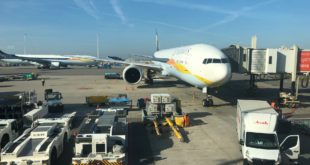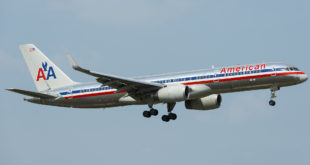Indian aviation continues to show tremendous aviation potential with growth forecast to be in the double digits for the next few years. Consensus forecasts indicate that India will be the third largest aviation market by 2026 after the United States and China. Both India and China will propel growth in the Asian region and consequently for the world economy.
The Asian region is critical for aircraft manufacturers and both Boeing and Airbus compete aggressively in it. With the slowdown in China’s growth along with its ongoing trade friction with the United States, the Indian market even is even more critical to aircraft manufacturers. Boeing is one such manufacturer. We examine Boeing Commercial Airplanes’ position in the Indian market and how it may be impacted by the challenges faced at Jet Airways.
Which airlines operate Boeing aircraft?
In the broader South East Asian region the large Boeing operators are:
| Airline | Number of Boeing Aircraft in fleet |
| Lion Air Group | 189 |
| Singapore Airlines Group | 124 |
| Garuda | 84 |
| Singapore Airlines | 53 |
| Malaysia Airlines | 48 |
| Thai Airways | 46 |
| Vietnam Airlines | 11 |
| Biman Airlines | 10 |
(note: fleet numbers are indicative and may vary from actuals)
The South East Asian market has some of the fastest growing aviation economies. Low cost carriers (LCCs) are dominating these markets and have driven aviation growth for countries such as India, Indonesia and Vietnam. Interestingly, Boeing has not done as well with LCCs as its competitor.
Coming to India, airlines that fly Boeing aircraft are as below:
| Airlines | Number of Boeing Aircraft in fleet |
| Air India | 45 |
| Air India Express | 24 |
| Jet Airways | 94 |
| SpiceJet | 46 |
An analysis of the fleet shows that there are approximately 700 commercial aircraft currently flying in the Indian skies. Of these, 32% are Boeing manufactured aircraft. Looking to the future, Indian airlines have more than a thousand aircraft on order and 42% of the orders are with Boeing.
Narrow-bodies versus Wide-bodies
The India commercial aviation fleet can also be analysed terms of narrow-bodies and wide-bodies. As a simple reference a narrow-body is distinguishable by a single aisle within the aircraft while wide-bodies have twin-aisles. Narrow-body aircraft are suited to short sectors while wide-body aircraft are mainly used for flying routes that are in excess of 6 hours (called long-haul flying). Using this categorisation, for the Indian skies, Boeing clearly dominates the wide-body category.
Specifically, of sixty two wide-bodies currently flying 87% are Boeing. For incoming orders, 80% of these are also Boeing. This excludes fleet renewals and changeovers that may come in the years ahead. For instance, Vistara has ten Boeing 787s on order but as it expands it could opt for additional aircraft. Similarly, once the Air India turnaround or disinvestment proceeds further, it will make a decision on fleet rationalisation. This may lead to additional orders for Boeing.
Overall as of now for the India market Boeing dominates the wide-body segment. For flying long-haul the Boeing product continues to be unparalleled. Perhaps summed up in this popular phrase in the flying community where they say, “if its not a Boeing, I’m not going.”
Jet Airways and its position in India
Jet Airways is one of the three full service carriers in India. It commands a 14.3% market-share and in the past was very successful. Over the years, the Jet Airways product, network and service were often commended. By extension, it has been a good story for Boeing.
Jet also is also only one of two airlines in India flying wide-body aircraft. While it has a mix of Boeing 777 and Airbus 330s in its fleet, due to its relationship with Boeing it is widely believed that it will switch to an all Boeing operation in the years to come.
But currently Jet Airways is grappling with challenges. These started with the rapid expansion of low cost carriers that drove lower fare levels. Aggressive fleet inductions by competitors further drove a supply demand imbalance. For Jet Airways, its dollar denominated debt, legacy costs and full-service structure added to the cost base and consequently heavy losses. As of now Jet Airways is actively involved in restructuring discussions the outcomes of which are yet to be determined. However, it continues to be a key player in the Indian market.
The Jet Airways fleet
Aircraft manufacturers fight to maintain market presence. For each market, Boeing tends to put up a strong fight when airlines are evaluating orders. As of now, Boeing has aircraft with four airlines namely, SpiceJet, AirIndia Express, Air India and Jet Airways. (Vistara was the newest airline in the country but it went with the Airbus 320 for its domestic fleet and has chosen the Boeing 787 for international expansion).
Jet Airways’ current fleet of 94 aircraft (including JetLite) is the second largest in the South East Asian region. The largest operator in this region is Lion AIr but with the recent incident involving their 737 Max8 (details can be found at: https://www.bangaloreaviation.com/2018/10/lion-air-jt-610-boeing-737-max-crashes-into-the-sea.html ) and their stated intention of reviewing the Boeing order, Jet becomes even more important. Other current operators that have large Boeing fleets include Malaysian Airlines, Thai Airways, Singapore Airlines and Garuda. But many of these are facing financial challenges.
Looking at future orders, Jet Airways’ order of two hundred Boeing 737s is also voluminous for the South East Asian region with other large orders being VietJet (100 aircraft), LionAir (230 aircraft) and SpiceJet (150 aircraft). Thus even regionally the order is quite critical to Boeing.
Why Jet Airways is critical to Boeing’s India presence
Airline fleet decisions are multi-billion dollar, long term decisions that are critical to market penetration for manufacturers. Once an airline chooses a certain manufacturer (usually Airbus or Boeing given the duopoly), it continues with new variants thereby giving the incumbent a strong presence in the market. Fleets also translate into additional market penetration for manufacturers with support services, spare parts, pilots type ratings and transition to larger variants. This has been the case with Jet Airways as well which has over the years developed a strong maintenance setup, training centers and a strong support network — all of which rely on Boeing.
As the Asian region continues to grow and with India forecast to be one of the growth engines, Boeing will definitely want to have a strong market presence here. And within this market, India is a growth engine. To that end, Jet Airways finds itself in the right market – at the right time. And regardless of challenges it still commands a 45% share of all Boeing aircraft being flown plus a similar share of all Boeing aircraft on order. This makes for a compelling proposition for market penetration.
Given the above, Jet Airways continues to be critical to Boeing’s India presence. And it is likely that Boeing will work collaboratively with the airline to ensure it continues flying.
 Bangalore Aviation News, Reviews, Analysis and opinions of Indian Aviation
Bangalore Aviation News, Reviews, Analysis and opinions of Indian Aviation


